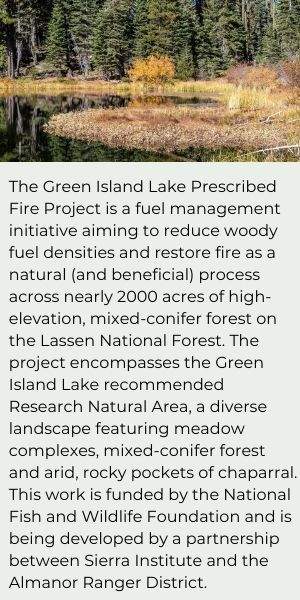By Kyle Rodgers and Noah Abramson
The Dixie Fire burned hot through several communities, reducing homes, businesses, and everything in between to piles of burned rubble. It is hard to reflect on positive fire effects when so much was lost, but looking across the landscape there are some hints of hope among the smoke.
Our forests need fire. Before the Dixie Fire, much of our area was among the most severely fire-departed forests in California. While researchers tell us that the forests historically burned every five to fifteen years, many of the areas that burned had seen over one hundred years without fire; a result of a century of successful fire suppression policies. Forests that historically experienced frequent fire had become formerly frequent fire forests.

When the Dixie Fire burned through over 900,000 acres, it was painful to watch. All too often the Dixie Fire burned hot and ran fast, moving through the canopies of trees as it made large runs. It was, for the most part, not the low intensity fire moving along the ground these landscapes depended on.

We watched in anguish at times as treasured parts of the landscape burned hot and fast under severe fire weather conditions, as appears to have been the case at the Green Island Lake recommended Research Natural Area – a beautiful remote area above the Feather River Canyon.
Undoubtedly, the future looks different in these areas. Our staff are committed to working with community members and partners to re-envision what it means to restore these areas.
What should post-fire management look like there? How do we create a landscape there that is resilient to the next fire?
There are some early indications that our restoration work may have helped some areas fare better than others. Meadow restoration at Rock Creek just north of Highway 36 appears to have aided firefighting efforts and limited the development of hydrophobic soils that repel water and hinder post-fire recovery which can be caused by extreme fire behavior. Years of fuel reduction treatments conducted by Sierra Institute staff and partners helped firefighters successfully protect the Juniper Lake Ranger Station and a number of other structures in Lassen Volcanic National Park.
Other places were left unburned. Along the West Shore of Lake Almanor, where we are working on a 6,000 acre restoration project in partnership with the Lassen National Forest, much of the canopy remains green. The Dixie Fire only underscores the importance of projects like this one that will reduce forest density, remove small trees that can spread fire to the canopy, and create forest stand conditions that increase the likelihood firefighters can keep the next fire from communities.
Learning to live with fire is an adaptive process. We’re committed to continuing our collaborative work across the landscape to restore resilience and provide livelihood support for community members working on the land.
Interested in helping our recovery efforts?


